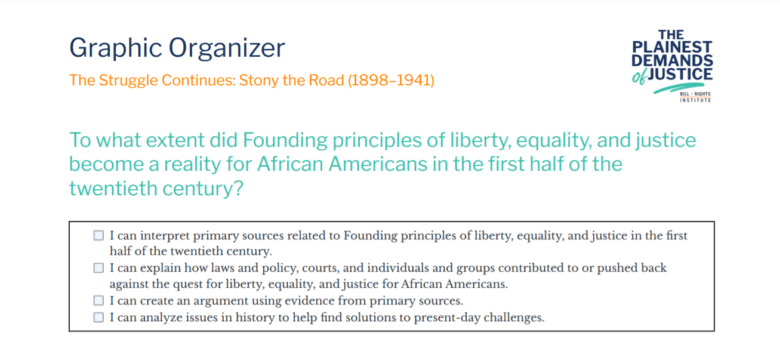Graphic Organizer: The Struggle Continues
To what extent did Founding principles of liberty, equality, and justice become a reality for African Americans in the first half of the twentieth century?
- I can interpret primary sources related to Founding principles of liberty, equality, and justice in the first half of the twentieth century.
- I can explain how laws and policy, courts, and individuals and groups contributed to or pushed back against the quest for liberty, equality, and justice for African Americans.
- I can create an argument using evidence from primary sources.
- I can analyze issues in history to help find solutions to present-day challenges.
Directions: Identify the main ideas and connections to the Founding principles using the information you gathered from your assigned documents.
| Document Title and Date | Main ideas | Connection to Founding Principles |
|---|---|---|
| Ida B. Wells, “Lynch Law,” 1893 | ||
| John Hope, “We Are Struggling for Equality,” 1896 | ||
| W. E. B. Du Bois, The Souls of Black Folk, 1903 | ||
| Giles v. Harris, 1903 | ||
| W. E. B. Du Bois, “Niagara Movement Speech,” 1905 | ||
| Map of the Migrant Streams of the Great Migration, 1910–1930 | ||
| Residential Segregation in City Zoning Laws, 1910–1911 | ||
| Booker T. Washington, “My View of Segregation Laws,” 1915 | ||
| Images of the Silent Parade, July 28, 1917 | ||
| Chicago Race Riot Images, 1919 | ||
| A Man Was Lynched Yesterday Flag (Replica), 1920–1938 | ||
| Tulsa Race Massacre Images, June 1921 | ||
| Racial Restrictive Covenants, Chicago, 1924–1946 | ||
| Langston Hughes, “The Negro Artist and the Racial Mountain,” 1926 | ||
| Zora Neale Hurston, “How It Feels to Be Colored Me,” 1928 | ||
| Langston Hughes, “Let America Be America Again,” 1936* | ||
| Federal Housing Administration (FHA) Underwriting Manual, 1938 | ||
| A. Philip Randolph, “The Call to Negro America to March on Washington,” 1941* | ||
| Bayard Rustin, “Nonviolence vs. Jim Crow,” 1942* |
